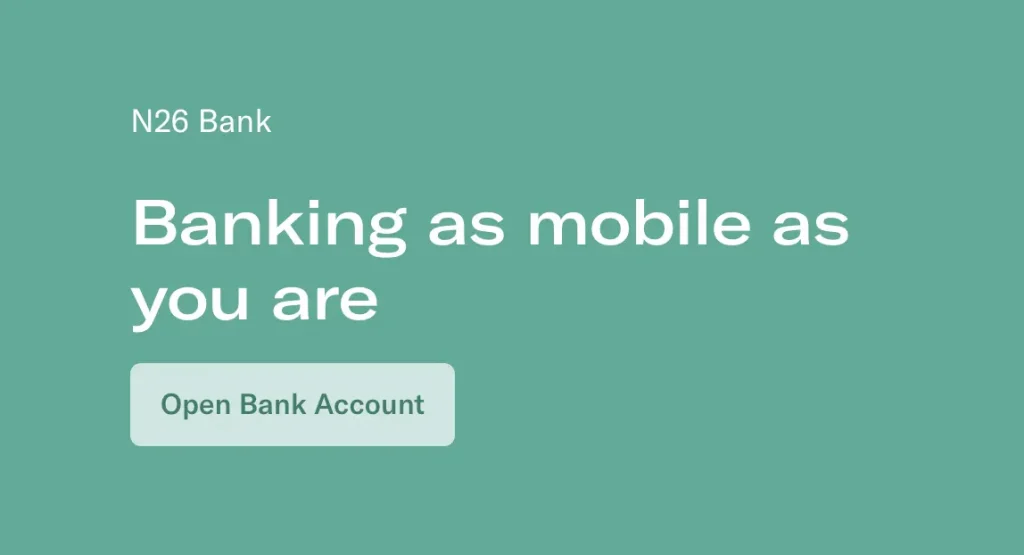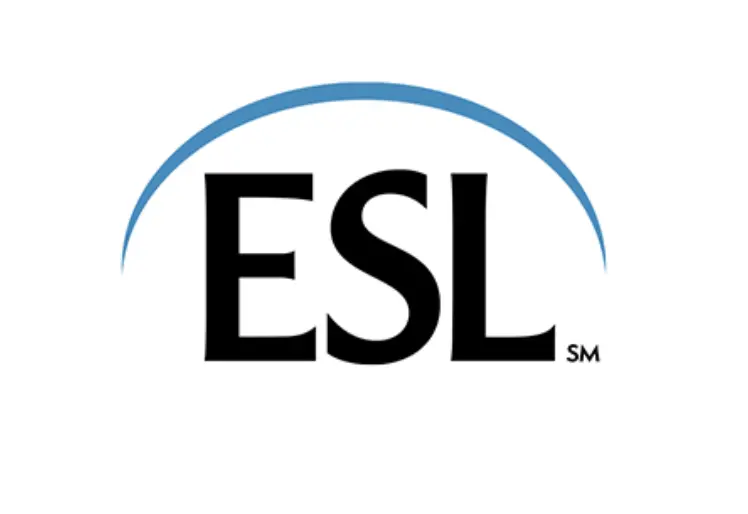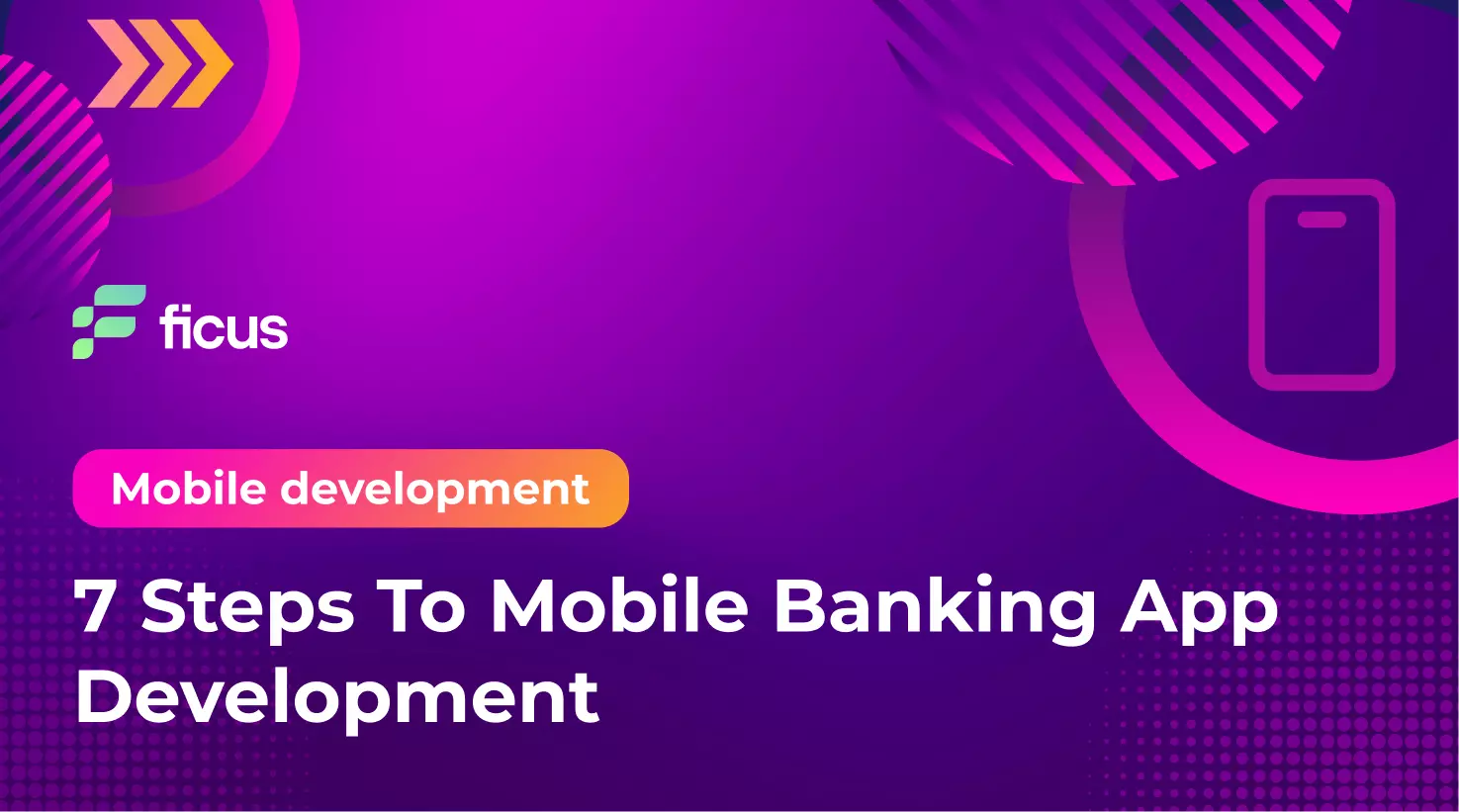As the financial sector evolves, the attractiveness of traditional banking, with its grandiose architecture and complex processes, is fading amid digital transformation. The shift to mobile banking application development reflects the growing preference for convenience, simplicity, and accessibility in financial management. As more and more people gravitate towards mobile banking solutions, there are more and more opportunities for fintech innovators to make their mark. In this article, we’ll look at the ins and outs of creating a mobile banking app, as well as its functionality, security, and competitive advantage, and guide you through the development process to meet the growing demand in the fintech market.
- Mobile banking development prioritizes user needs and data security.
- Fintech market entry with a mobile app offers vast opportunities.
- Ficus Technologies provides expert guidance in creating mobile banking apps.
What is Mobile Banking?
Mobile banking development means a shift in the banking industry model that adapts to and outpaces digital innovations. This shift is epitomized by mobile-only digital banks, which encapsulate a smartphone application’s full range of banking operations. This development marks an era where banking services are becoming ubiquitous, intuitive, and tailored to users’ digital lifestyles. With various applications offering unique features and bonuses, mobile banking replicates and extends the traditional banking experience, allowing users to choose a digital bank that suits their preferences.

Pros and Cons of Mobile Banking
The analysis of mobile banking application development reveals its advantages and pitfalls. It provides an opportunity to understand its impact on everyday financial activities and decision-making between digital and traditional banking methods.
Pros of Mobile Banking Apps
Pros of mobile banking application development encompass:
- Easy setup: Easily register, verify identity link accounts, and use the app quickly.
- Lower fees: Reduced overhead results in fewer and lower fees than traditional banks.
- User-centered design: 24/7 customer support, intuitive interfaces, and attractive design all contribute to increased trust and satisfaction.
Cons of Mobile Banking
Challenges in mobile banking product development include:
- Security risks: Despite improved security measures, the risk of data vulnerability remains, affecting user confidence.
- Lack of physical ATMs: Without their ATMs, users may face high fees at third-party ATMs.
- Lack of personal service: The digital model eliminates the possibility of in-person banking, limiting service flexibility and depriving customers of the human contact that some value.
Innovation is the ability to convert ideas into invoices.
Lewis Duncan
Features of Mobile Banking
The success of mobile banking application development depends on including a set of core functionalities that meet and exceed user expectations. Let’s examine the main characteristics that determine their effectiveness and attractiveness.
Financial operations
Financial transactions, which enable users to manage their finances with unparalleled ease, are at the heart of mobile banking development. These platforms serve as digital wallets and bank accounts, allowing users to store and control funds, make quick transfers, make seamless online and in-store payments, make deposits, and even apply for small loans and overdrafts.
Secure interaction
Secure interaction is a priority in mobile banking application development, both as a starting point and a focus throughout the application’s lifetime. Multi-factor authentication, end-to-end encryption, and secure back-end architecture ensure digital security for users. Robust UX design and adherence to coding best practices further protect the app from potential vulnerabilities. This positions security as the alpha and omega of mobile banking development.
Engaging User experience
Mobile banking development must prioritize entertainment and engagement to revolutionize the user experience. Banks can foster a more interactive relationship with their users by implementing customizable interfaces, quick notifications, and gamification features such as achievements. Achieving a seamless user experience (UX) ensures satisfaction and increases user retention and loyalty. This shift to an entertainment and user-centered model differentiates mobile banks from their traditional counterparts, making banking a necessity and a pleasure.
Ready to innovate in fintech technology?
Contact us5 Mobile Banking Development Challenges
The process of mobile banking application development is fraught with challenges.
In the following paragraphs, I will divide my experience into five main challenges to help developers understand these complexities.
Biometric authentication
Integrating biometric authentication into mobile banking application development goes beyond a simple technical feature; it is a key to security and user experience. Implementing Face ID and Touch ID has revealed significant challenges, especially on Android devices. These challenges highlight the delicate balance between ease of access and protection of sensitive information, underscored by the need for careful planning and implementation of measures to protect user data.
KYC verification
The KYC verification process, a key component of mobile banking application development, presents its challenges, primarily due to the shortage of qualified risk analysts. This shortage can significantly lengthen the time it takes to hire such specialists. However, solutions such as alloy.com can simplify the KYC process by ensuring that user identities are verified efficiently and effectively, thus maintaining the banking application’s integrity and reliability.
3rd parties integration
In mobile banking application development, integrating 3rd-party services often turns out to be more complicated than originally anticipated. The process of concluding agreements with these vendors typically exceeds the expected timeframe, often resulting in eleven hours of completion. This delay halts the development process and forces developers to work with preliminary data, extending the timeframe to achieve full integration. Such scenarios require rebuilding large portions of code to ensure compatibility with 3rd-party applications, potentially extending development by another sprint or two. To mitigate these issues, it is recommended to allocate separate time for 3rd-party integration and include it in the planning phase from the beginning.
Fast-changing requirements
Mobile banking development in the US market, known for its rapid fintech technology evolution, requires patience and adaptability. Frequent changes in requirements and business logic require a design approach in which the application and its code base are structured for easy and rapid modification. This reality emphasizes the need to prepare to adapt the product architecture to these rapid changes without compromising development speed or product integrity.
Legal regulations
Mobile application development for banking requires strict compliance with legal regulations to ensure the security and trust of users:
- PCI DSS: This global standard protects cardholder data across the payment industry.
- CCPA: To strengthen consumer privacy rights, applications targeting the United States, specifically California, must comply with the California Consumer Privacy Act.
- GDPR: Entering the European market requires compliance with the General Data Protection Regulation, which protects personal data within the EU.
- PSD2: This directive encourages innovation in online and mobile payments, improves security, and strengthens consumer protection in the EU and EEA.
These rules define the development process, guiding security measures and privacy policies to ensure the protection of user data and compliance with legal requirements.
Importance of UX for Mobile Banking Apps
In mobile banking development, user experience (UX) directly impacts user satisfaction and retention. A well-designed UX simplifies navigation and transactions, builds trust, and encourages continued use. In the following paragraphs, we’ll examine how achieving optimal UX can increase mobile banking’s success.
Interactive Banking Experience
For mobile application development for banking, an interactive application enhances user engagement. The tactics include:
- Allowing content to be shared and liked stimulates interaction.
- Incorporating Easter eggs that give the joy of discovery.
- Gamification of the experience, rewarding the achievement of financial goals.
- Creating concise, interesting notifications that do not annoy users.
- Include short video updates that improve communication.
- Add humor and soften the tone.
Intuitive Banking Experience
Crafting an intuitive user experience is a priority for mobile banking product development. The main elements include
- Adaptive interfaces that personalize based on user activity, making frequently used functions easily accessible without cluttering up the display.
- Concise screens that display only the information you need, such as account balances and transaction options, ensuring ease of use.
- Smart transactions adapt based on the type of transaction, offering features such as account splitting and relevant financial details.
- Integration with external services to automatically collect information from contacts to complete transactions, simplifying the process.
Customizable Banking Experience
For mobile application development for banking, it is very important to offer the user a personalized experience:
- Create a responsive interface with extensive customization options for a personalized approach.
- Allow users to change design elements such as colors and fonts, increasing accessibility and individuality.
- Introduce bonuses and achievements to reward the achievement of personal financial goals by adding a gamified aspect.
- Build in a personal financial advisor feature to help with budgeting, spending limits, and in-depth financial advice, using smart algorithms to offer users customized financial information and help them save effectively.
How To Develop An Online Banking Application?
Mobile banking development involves several key steps – from idea to launch.
These steps will help you create a reliable, secure, user-friendly online banking app. Dive into the following sections to learn a comprehensive plan for developing a successful banking app.
Step 1 – Research
Launching mobile banking development demands comprehensive research. This fundamental action includes evaluating the marketplace, comprehending competitors, and grasping potential customers’ cultural subtleties and behaviors. For example, acknowledging the prevalence of credit card use in particular markets can considerably influence the app’s features, such as the incorporation of credit options. Results of this phase include in-depth customer personalities, market insights, competitor standings, widespread market behaviors, and a clear, worthwhile proposal, laying the groundwork for targeted and reliable app development.
Step 2 – Prepare the Security Base
For mobile banking product development, security is not just a feature but the foundation. Effective protection of sensitive user data requires several key security measures. Hashing passwords before storing them in the database is essential to protect user access. Implementing automatic logout protocols for inactive users after 15 minutes strengthens protection against unauthorized access. Access to user data, including tokens and passwords, should be limited, and information should be stored on secure platforms such as 1Password or Okta. Providing the app with security certificates, such as SSL for the web or SSL Pinning for mobile apps, is crucial to maintaining data privacy. Additionally, using secure authentication methods such as fingerprint scanning for Android and Apple KeyChain for iOS, as well as VGS to display card information securely, protects the app from hacking.
Step 3 – Develop & Test a Prototype
In mobile banking development, creating and testing a prototype is a direct way to get feedback from users at an early stage. This early version, which includes the logic, structure, and design of the app, provides a practical way to evaluate how users interact with the core functions of the app. Although the prototype may not fully reflect the final product’s functionality or design, it is an important tool for determining what resonates with users and what needs improvement. Through this process, developers can make informed adjustments to ensure that the final app best meets users’ expectations and needs, increasing user satisfaction and engagement.
Step 4 – Design UX & UI
In mobile banking product development, the transition to designing UX and UI directly addresses user anxieties regarding financial transactions. Given users’ apprehension when managing their finances online, such as applying for credit cards or transferring large amounts of money, the emphasis on creating intuitive, simple designs becomes obvious. Using the results of user research, interviews, and feedback on prototypes, designers focus on creating interfaces that simplify these processes, increasing trust and reducing the likelihood of errors. This approach reduces user anxiety and fosters a positive, trusting experience with the banking app, encouraging continued use.
Step 5 – Mobile Banking Software Development
Choosing the right development framework begins the actual mobile banking product development phase. For platforms such as Android and iOS, Native app development is the best choice due to its advanced security features compared to alternatives such as React Native. This solution builds app integrity and user trust, which is crucial for financial apps. Using Swift, XCode, and iOS SDK for Apple devices, Java or Kotlin, Android Studio, and Android SDK for Android, guarantees application reliability and user satisfaction, providing a secure and efficient online banking solution.
Step 6 – Integrate 3rd Parties
Integrating third-party services into your app simplifies the user experience and adds valuable features that can differentiate your offering in the competitive mobile banking development market. Services such as Segment for analytics, Iterable for notifications, Onfido for identity verification, Plaid for financial data connectivity, and Sendbird for messaging enrich the app’s functionality. The decision to include these tools depends on their reliability, security, and support, ensuring they positively impact app performance and user satisfaction.
Step 7 – Release. Maintain. Improve.
After successfully overcoming security issues, creating an intuitive user interface, and integrating the necessary third-party services, it’s time to launch. This crucial step in mobile banking development opens a new phase when the application begins to live and breathe in users’ hands. Feedback and interaction with users indicate the need for continuous improvement and the introduction of new features. Be prepared to transform your initial app by adapting it to new needs and expectations, sometimes in a transformative way.
Examples of Mobile Banking Apps
Analyzing top mobile banking application development cases is invaluable for creating a leading digital banking app. In the following paragraphs, you will learn what sets these apps apart.
Monzo

Monzo, a UK-based digital bank, is a leader in mobile banking development. Its user-friendly design and rich feature set include check splitting, easy money transfers, debt tracking, payroll management, and fee-free withdrawals. Monzo’s aesthetic appeal and functionality put it at the forefront of the UK digital banking sector. It outperformed competitors such as Revolut by directly addressing the needs and preferences of modern banking customers.
N26

N26, a German company, has made significant strides in mobile banking development. It serves customers across the EU, the US, and Switzerland and plans to expand to Brazil. Serving mostly freelancers and self-employed individuals, N26 embodies the essence of digital banking by offering basic services without complex additional features such as automatic savings calculation or IFTTT integration. This approach positions N26 as a simplified and efficient choice for simple digital banking solutions.
ESL Mobile Banking

ESL Mobile Banking, an extension of ESL Federal Credit Union based in the US, represents a significant mobile banking development within the traditional banking sector. This platform provides simple and efficient mobile banking, allowing users to check accounts, transfer money, and manage personal information using their mobile devices. Far from being a neo-bank, ESL Mobile Banking demonstrates how established financial institutions adapt to digital demands, offering a noteworthy example of the digital transformation of traditional banking.
Final Words
Mobile banking application development marks a significant leap forward in meeting users’ needs. People are no longer tied to long lines at banks; now, a few taps on a mobile app allow them to complete tasks in minutes, not hours. This shift, however, emphasizes the need for increased attention to data privacy. Incorporating a dedicated security phase into the development process addresses this issue and creates unique challenges that enrich the process.
At Ficus Technologies, we are committed to making your mobile banking vision a reality. Our team is always ready to help you at every stage and ensure the success of your project.
Mobile banking requires several key components: a secure and user-friendly mobile application, a robust back-end infrastructure for transaction processing and data storage, strong encryption methods for data protection, compliance with financial regulations and standards, integration capabilities with other banking and financial systems, authentication and fraud detection mechanisms to protect users, and customer support for app users. In addition, it should offer a wide range of banking services, including account management, fund transfer, bill payment, and mobile check deposits. Ongoing updates and maintenance are essential to ensure security, functionality, and compliance with user needs and technological advancements.
AI can greatly enhance mobile banking by personalizing the user experience, offering customized financial advice, and improving customer service with chatbots that provide instant assistance 24/7. It can detect and prevent fraud more effectively by analyzing transaction patterns and detecting anomalies that indicate fraudulent activity. Additionally, AI optimizes operational efficiency by automating routine tasks such as data entry and analysis, freeing up human resources to address more complex issues. AI-powered analytics can also help banks better understand customer behavior, enabling them to develop new services or products that meet evolving customer needs and thus foster engagement and loyalty in a competitive banking sector.








